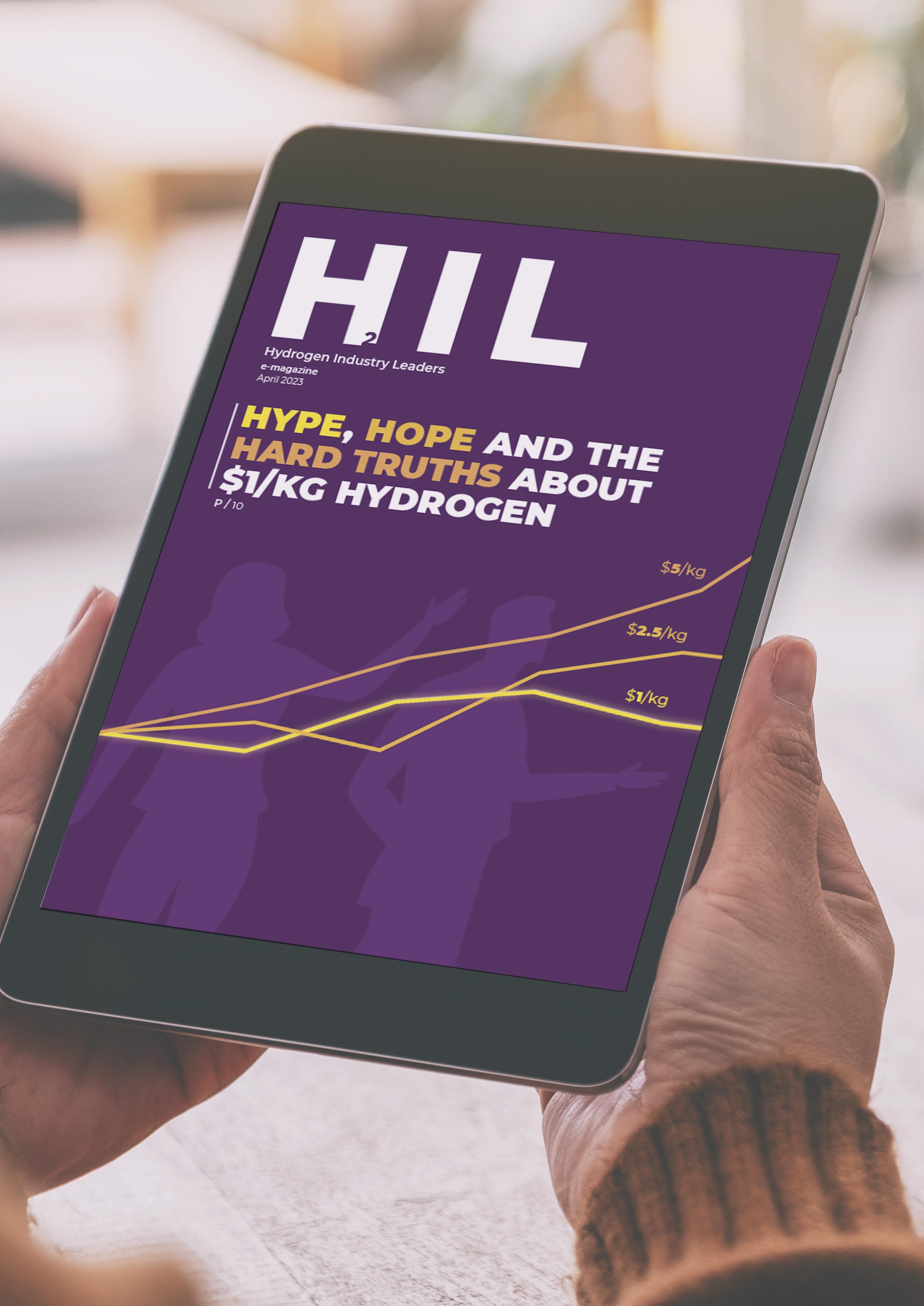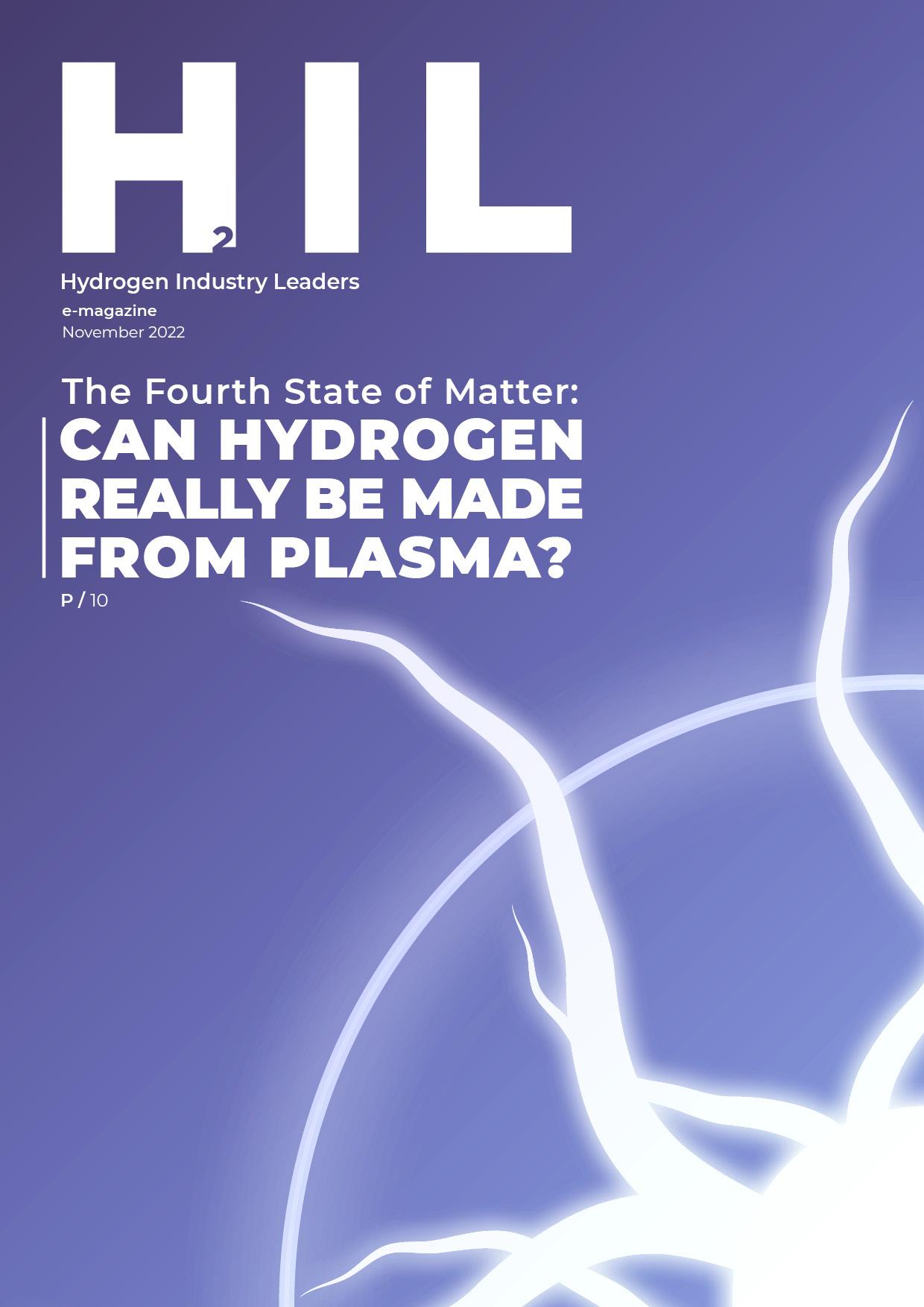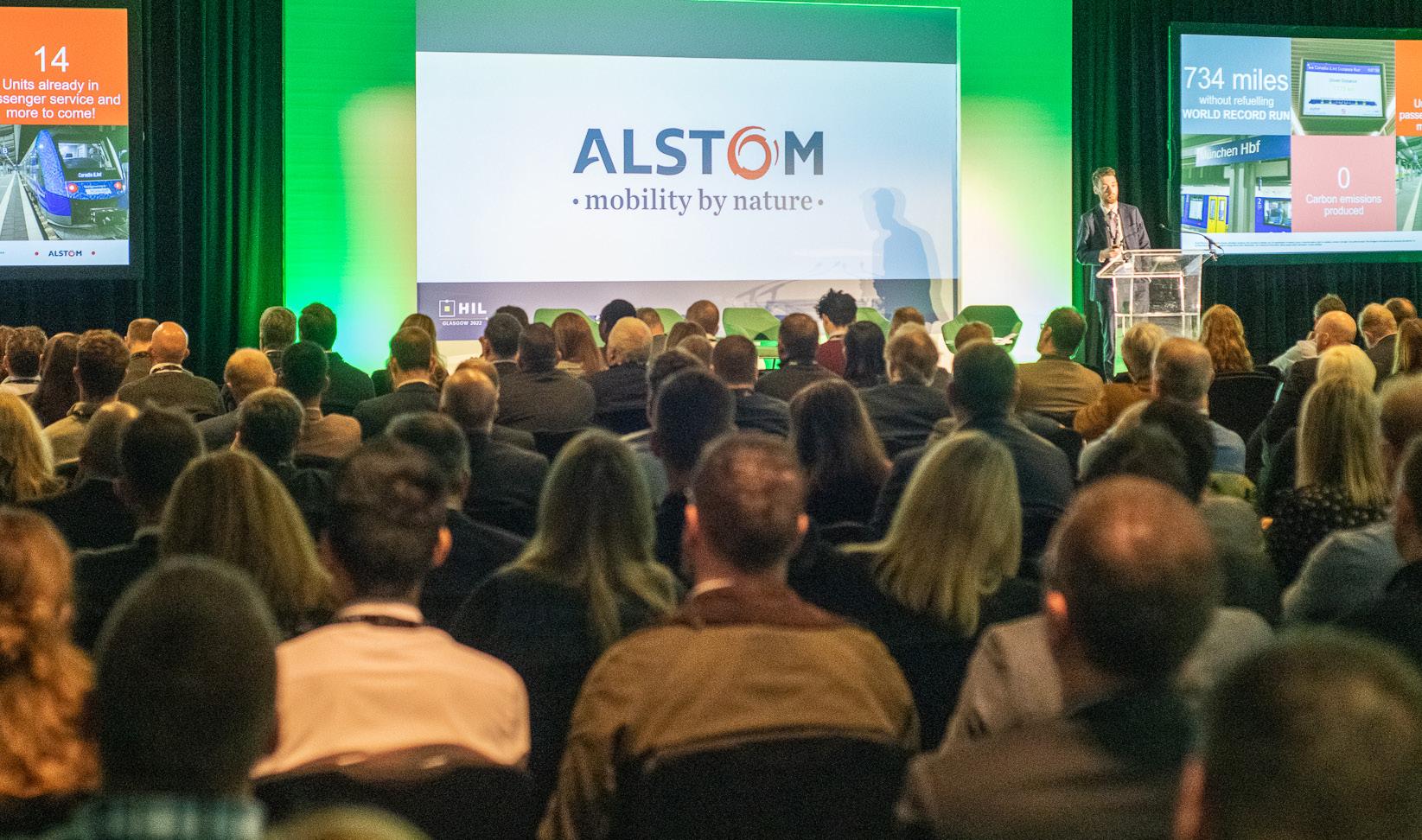CONTENTS
P / 06
EIC Calls Powering Up Britain Plan “Underwhelming”
P / 04
Controversial EU Delegated Act Defining Green Hydrogen Near Clearance
P / 06
EIC Calls Powering Up Britain Plan “Underwhelming”

P / 08
France Hopes to Deliver Hydrogen Production at Record Pace
P / 10
Hype, Hope and the Hard Truths About $1/kg Hydrogen
P / 12
Bristol Breakfast Event Highlights
P / 12
Bristol Breakfast Event Highlights

P / 10
Hype, Hope and the Hard Truths About $1/kg Hydrogen
P / 14
Climate Anxiety: Is Education the Best Medicine?
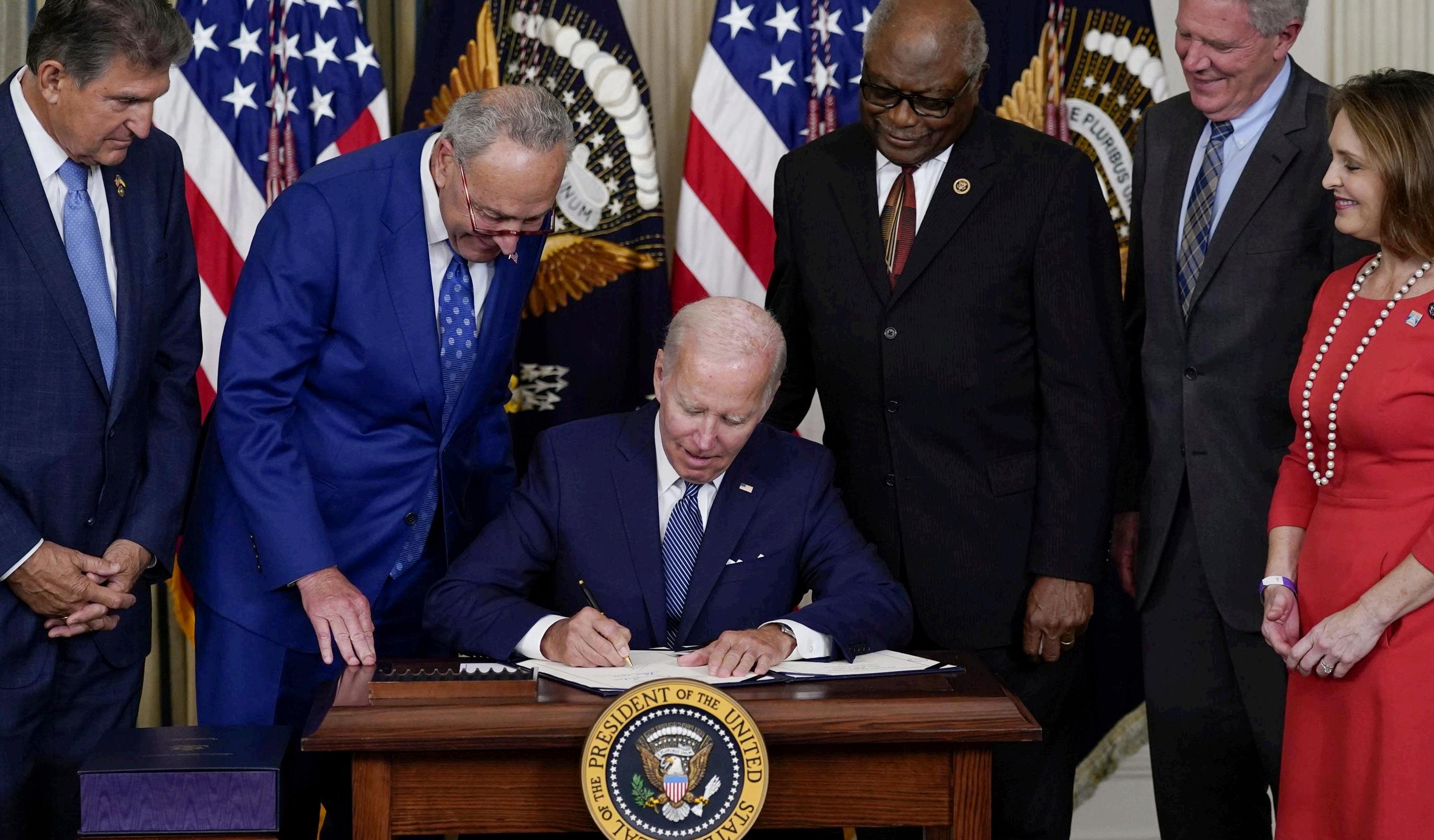
P / 16
International Projects
P / 18
HIL London
P / 19
Previous Editions
P / 20
HIL London Next Up
HYPE, HOPE AND THE HARD TRUTHS ABOUT $1/KG HYDROGEN

If the US is to meet $1/kg of Hydrogen, there must be significant subsidies.


EU DELEGATED ACT
CONTROVERSIAL EU DELEGATED ACT DEFINING GREEN HYDROGEN NEAR CLEARANCE
With the parliamentary committee on industry, research, telecoms & energy voting against official objections to definitions of green hydrogen, the European Parliament has now effectively agreed to the somewhat controversial Delegated Act.
The approval of the Delegated Act, which provides rules on how green hydrogen can be produced, regulated and subsidised, has had significant delays due to objections to definitions from centre-right European People’s Party.
With the vote against the objections passing, it cannot now be heard by the full European Parliament in a plenary session and, therefore, cannot be upheld.
While this is a significant hurdle passed for the European Commission, the key piece of EU regulation which solidifies rules still needs approval from member states. Controversial definitions of green hydrogen have caused a stir amongst some states, but the Act is still expected to pass.
Approval of the Act is imminent
The Act could be passed before the end of April 2023, with many people expecting it to come even sooner as the Council of ministers meets to discuss the Renewable Energy Directive and the Delegated Act, which is an appendix of the Directive.
High on the agenda of discussions will undoubtedly be whether nuclear hydrogen can be considered renewable. If passed, this could speed up the processes of delivering a healthy capacity for hydrogen production, but issues around emissions and decommissioning may go against the very agenda of net zero set by the European Commission.
If negotiations break down and the sector remains without a clear definition of green hydrogen, additionality and temporal correlation issues, which are already highly complex issues, may become even more compounded. This will see a continuation in the trend of FID and hamper the growth of the hydrogen economy across Europe. This has led to industry leaders in the sector taking the position of ‘any definition is better than no definition’ with future talks and improvements being able to react to the changing landscape of the hydrogen sector as it unfolds.
Issues around additionality seemingly cleared
Previously publishing the proposed Delegated Act in February 2023, additionality issues were at the heart of debates to ensure that green hydrogen is not produced using renewable energy that would otherwise have been used to provide zero-carbon electricity to the grid. There were wide conclusions that all renewable electricity used to produce hydrogen would need to be new to ensure emissions wouldn’t rise with fossil fuels making up for the loss in renewable capacity used for green hydrogen production.
Hopes that an agreement can be met on this issue are growing after an agreement on additionality was met. This explained that the additionality principle is renewable projects that came into operation no earlier than three years before the installation of the hydrogen project or its derivatives, otherwise known as RFNBOs.
Monthly Correlations are still on the cards - for now
With green hydrogen comes serious debates surrounding the intermittency of renewable power and whether the grid will be used to supply the electricity in downtime periods. Power from the grid may be from fossil fuel use, which then breeds debate around the fair correlation between grid electricity and renewable electricity.
Larger debates are swirling around under what circumstances this would be allowed and how this will be regulated to ensure it isn’t used as an off-setting mentality with extra steps. One side of the argument suggests that allowing grid use might become the default, and investment could be better spent on R&D to improve storage and tackle intermittency.
Others argue that allowing the use of grid electricity intermittently will help keep the levelised cost of electrolysers lower than if they were turned on and off, allowing for a continuous stream of hydrogen to be produced and keeping costs lower.
Trade associations have called for monthly correlations to help balance the use of the two, with the European Commission originally indicating it could be hourly. Monthly correlations are permitted until December 2029; thereafter, only hourly correlations will be acceptable.


POWERING UP BRITAIN
EIC CALLS POWERING UP BRITAIN PLAN “UNDERWHELMING”
In response to the Powering Up Britain Plan, industry-leading associations have been commenting on the action plans and what this means for the shape of the hydrogen economy.
The EIC expressed the need for clarity on project timelines may be causing uncertainty for supply chain businesses across the energy industries.
The Energy Industries Council described the UK government’s Powering Up Britain plan as underwhelming, saying the muchawaited announcement is not likely to encourage supply chain businesses to remain in the UK.
More comprehensive measures needed to catch the EU and US
They have called for more comprehensive measures to be implemented in support of the UK’s energy industry. Additionally, it has been noted that there currently needs to be a timeline in place for the projects detailed in the government policy documents, including CCUS.
The EIC stressed that the scale of these announcements needs to be revised to counter major green energy initiatives by the United States and Europe and does little to encourage businesses to stay in the UK. Highlighting this, Neil Golding, the Head of Market Intelligence, said: “Our impression is that this [the announcement] is underwhelming in terms of scale and clarity and does not appear to add anything new. The lack of clarity is causing uncertainty for supply chain businesses across the energy industries.”
Continuing, he firmly stated: “There appears to be very little new in the announcements made today, more a rebadging of previous announcements. The supply chain is continually waiting for new pipelines of projects to develop. However, we always seem to fall short of setting timescales and clear objectives. This means that we are failing to seed and root our supply chain in the UK.”
The announcement seemed to underappreciate the significant contribution of the oil and gas supply chain to the UK’s energy security and economy, as well as its role in the transition to cleaner energy sources.
The EIC welcomes an open dialogue with the UK Government to discuss how we can work together to develop more robust and sustainable policies for the energy sector.
Neil Golding Head of Market Intelligence EICWith today’s statements, the government aims to deliver almost half a million new green jobs by 2030, supporting a shift towards cleaner energy sources to power more of Britain from within the country.
Reaffirmed commitments but no new investment
The plan includes reaffirming a previous commitment to Carbon Capture Usage and Storage, the launch of a £160m fund to support port infrastructure projects for floating offshore wind, the backing of green hydrogen production projects and £380m investment in EV charging points.
Many had hoped that this would be the UK’s response to the Biden administration’s Inflation Reduction Act, which has already prompted some of the EIC members to explore the American market as a more viable option, according to the association.

Vysus Group’s SVP Commercial, Malcolm Cameron, said: “We are acutely aware of the challenges associated with achieving our net zero ambitions in the UK. We need to ensure investors have confidence in the UK energy sector if we are to have any chance of speeding up the energy transition and closing the gaps to meet our global targets.”
He added: “While we would have to say these measures do not go far enough, anything that the government can implement to accelerate a cost-effective, balanced transition to a lower carbon economy through clean and sustainable technologies whilst acknowledging the role hydrocarbons still have to play in our energy mix, is to be welcomed.”
The government made no reference to an anticipated reduction of the Energy Profits Levy, which has already reduced investments in the North Sea.
“Various projects and commitments that would have otherwise been awarded to the supply chain were postponed or withdrawn entirely as operators revised their plans and reduced spending in response to the windfall tax, which left them with less available cash,” said John Petchey, EIC Membership Manager for Scotland and Northern Ireland.
RECORD PACE
FRANCE HOPES TO DELIVER HYDROGEN PRODUCTION AT RECORD PACE
With the second production site in Morbihan expected to be operational in the second half of 2023, with support from ADEME, France is hoping investments in hydrogen production will pay off if capacity grows at a record pace.
In order to achieve this, it is essential that public investment is there to build the initial projects and production capacity before enabling private investment in the future.
Today, the hydrogen sector is developing in France as elsewhere. The first solutions to be produced are almost “handicraft” in nature, and their price is naturally high.
Governments, which have understood its interest in decarbonising entire sectors of industry and mobility, have - as with any promising sector - set up support plans to encourage and accelerate its start-up.
Finance alone isn’t enough; the sector needs direction
However, providing finance alone isn’t enough to secure a hydrogen economy fit to support domestic needs and offer opportunities for export in the future. Well-supported direction is the key to any kind of success in building enough capacity to meet growing needs. This can be through verification schemes, allocation rounds and CfDs.
Speaking to hydrogen industry leaders, Antoine Hamon, Deputy CEO and COO at Lhyfe, explained: “At Lhyfe, we believe that it should be directed primarily towards users because they are the ones who are currently dependent on fossil fuels and who must change their production tools, their fleets, their processes, etc.”
He continued to state: “We, the producers, need customers more than subsidies. Subsidies are decisive in helping hydrogen users (local authorities, companies, manufacturers, etc.) take the plunge. When they place massive orders, industrialisation will naturally bring prices down.”
Further direction could include public aid to finance infrastructure (e.g. refuelling stations to ensure proper coverage of the territory), the setting up of training programmes, etc.
For producers and manufacturers, we can confirm that there is a lot of private investment available. At Lhyfe, in 4 years, we have raised around €184 million
Antoine Hamon Deputy CEO and COO LhyfeHowever, as previously noted, the ADEME supports the Lhyfe Bretagne site via the supra-regional VHyGO ecosystem, as well as other projects. Lhyfe is applying for the aid that is available to producers in order to remain competitive.
Scalable solutions are no longer a pipe dream
Ensuring Lhyfe can be at the forefront of innovation and build production capacity at a rapid pace, placing France in a unique position in the race to be a hydrogen exporter across Europe and beyond.
Elsewhere in France, in Bouin, the production unit is directly connected to a wind farm, the first in the world, celebrated its 100th container of hydrogen at the end of 2022.
Two world firsts have enabled Lhyfe to position itself at the forefront of the innovation required to support the scale of hydrogen containers at the site. World-first technologies have been
the bedrock of development in France
In 2021, Lhyfe inaugurated the first industrial-scale green hydrogen production plant in the world to be interconnected with a wind farm in Pays de la Loire.
Building on this, in 2022, Lhyfe inaugurated the first offshore green hydrogen production pilot platform in the world (Sealhyfe).

Explaining the unique advantages this brings to Lhyfe, Antoine said it provides: “Credibility with project developers, who are calling on us massively throughout Europe. We are currently working on 9.8GW, i.e. about a hundred projects, and we want to have installed 3GW by 2030.”
Focusing on developing technologies and production capacity also offers wider knowledge and innovations to other aspects of the energy transition.
Antoine expanded on this: “Any sector undergoing transformation needs a pure player to accelerate its transition. Like Tesla for the electric battery for example. Our ambition is to contribute to accelerating the development of the green and renewable hydrogen sector.”
“The fact that we have been able to demonstrate that it is possible today to produce hydrogen from wind turbines, and at an affordable price, has unlocked many barriers.”
This is what Lhyfe also want to do for the production of hydrogen at sea with Sealhyfe. They are convinced that these projects will save the industry precious months, even years.
One of the biggest barriers to the growth of the hydrogen economy is the ability to develop projects at a big enough scale to start to contribute significant volumes of hydrogen into the sector.
Lhyfe, alongside many other players in the sector, has set ambitious targets to overcome this bottleneck.
They have set the target to move from 750kW to 2.5MW by 2024, which is no small feat.
In 2019, when they launched the Lhyfe Pays de la Loire site in Bouin, this capacity more than doubled the installed electrolysis capacity in France.
Today, the market has evolved. The Lhyfe Bretagne site (which will come on stream in the second half of 2023), for example, will eventually have a capacity of 5MW. The expansion of Bouin was planned from the start, and everything was designed in this sense. The main action will consist of adding cells to our electrolyser to increase its power to 2.5MW at the beginning of 2024.
$1/KG HYDROGEN
After extensive analysis of the forecast of hydrogen pricing by 2031 by the DOE, it was recently found US clean hydrogen producers are unlikely to meet President Biden’s ambitious target of cutting costs by 80% to $1/kg without subsidy.

Despite the pessimism of reaching the ambitious target without intense subsidy, it could be achieved if the US builds additional research and development into their existing work programmes, new analysis from the US Department of Energy (DOE) also found.
It is worth noting that significant reductions in the price of hydrogen/ kg are still expected from $3-5/kg. This would provide a cost reduction of around 60 per cent. However, more could be done to ensure this comes into a competitive price to incentive more private investment and uptake in hydrogen use.
$1/kg target slowly slipping away
These reductions would be an effect of expected cost declines in renewable electricity and electrolysers but would only work with the expected rampup of reliable hydrogen storage and distribution infrastructure.
Global cost increases and supply chain issues may cause temporary price differences and could stall the beginning of many projects, but with the IRA coming into force across the states, these issues could be ironed out sooner than expected.
The report expanded on this: “Expects the capital costs of (uninstalled) alkaline electrolysers
to plummet by 70% to $230-400/kW by 2030, while proton exchange membrane (PEM) electrolysers fall by 60% to $380450/kW.”
Research and innovation advances will also help reduce costs across the board as the sector finds more efficient ways of working and producing hydrogen. R&D for innovation has been supported through a bumper $750m hydrogen research and development fund, which aims to overcome technical barriers to cost reduction.
Reaching the target set by President Biden: “Would require additional [research and development] compared to what industry players are building into their current forecast,” the DOE said.
Other renewable developments proving
to be a bottleneck for green hydrogen
Renewable energy installations are also a core concern to meeting these targets, as the US would require a further 200GW of new wind or solar capacity to meet the 2030 goal of 10 million tonnes of hydrogen per year for domestic consumption, let alone the target to help reduce the costs to $1/kg.
This would be an effective doubling of the US’s current wind and solar capacity of 226GW and enable the US to achieve 90% of its target with green hydrogen, the DOE said, noting that this would also require an electricity price of $20/MWh.
Long-term viability for hydrogen looking good despite $1/kg doubts
Looking at the long-term viability of hydrogen more closely, the report found: “Electrolysis projects that claimed the
PTC are more likely to operate at full utilisation after the PTC sunset due to fully depreciated capital assets compared to projects built post-PTC expiration.
In the long-term, the economic viability of hydrogen production projects will vary by off-taker (dependent on the offtaker’s willingness to pay), the hydrogen production technology, and whether the project began construction before or after the PTC sunset in 2032.
Most industrial use cases have the sufficient willingness to pay to justify new construction after 2032 and continued operations of existing projects that no longer qualify for the PTC after ten years in operation.
Without these cost-downs, producers may pass prices onto consumers, dramatically increasing the price to cover operational expenditure. This is most likely to happen after the PTC ends. This is why it is essential that the levelised costs are reduced in this time period.
Setting out broad guidelines in ways the hydrogen market could develop until 2035, the report broke down the process into three stages:
• Near-term expansion to 2026 prioritising the decarbonisation of the US’s current hydrogen usage, mainly in ammonia production and oil refining
• A scale-up is driven by research and development and which pushes down costs further
• A self-sustaining market that operates cost-effectively without subsidies
These three stages require substantial private investment across the US and really on the previous steps being executed effectively.
Navigating the obstacle that comes with each stage will require a lot of holistic thinking, and the long-term vision will need to be continued with successive presidencies, something that is riddled with further challenges.

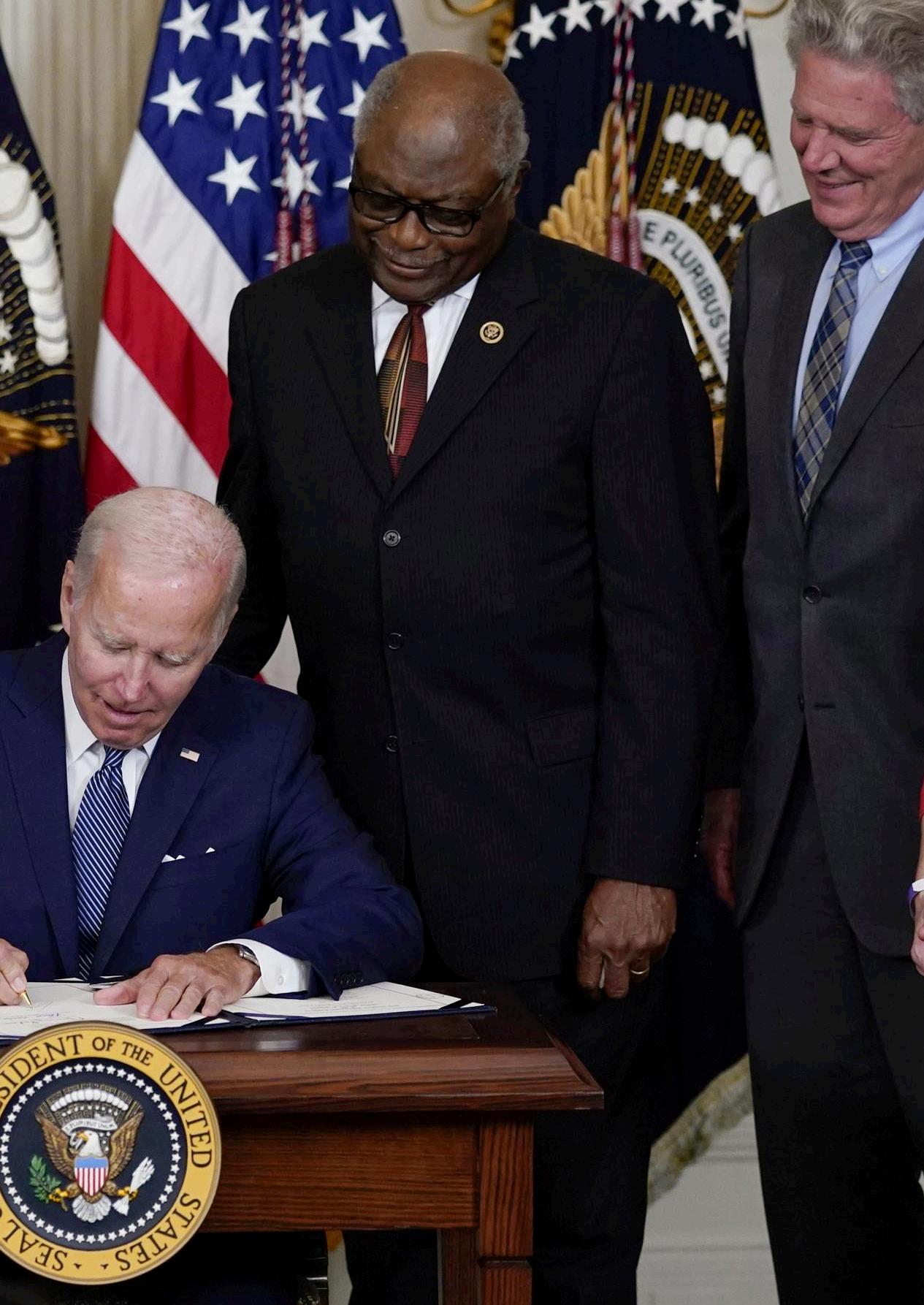
BREAKFAST HUB
BRISTOL BREAKFAST EVENT HIGHLIGHTS
After the successful HIL 100 Breakfast Hub Bristol event, Hydrogen Industry Leaders highlights the main takeaways from the panel discussion.
The panel discussion featured Richard Bonner - Chair of the West of England Local Enterprise Partnership, David Eccles – Hydrogen South West Lead, and Debby Skellern – Hydrogen Lead at the Western Gateway.
With its international connections, a rich aviation sector, and cutting-edge research facilities, the South West region of the UK has the talent, resources and connections needed to make it the perfect spot for hydrogen investment.
The UK hydrogen economy could grow from Bristol
Richard addressed the audience and explained that the South West is uniquely positioned to create a link between a number of industrial clusters and there are two key things that the industry needs to focus on.
He said: “We have got great assets, and we need to build from those small acorns to really accelerate those into industrial scale ideas. We need the right policy framework in place and work out where we need to shape the local or national policies to help us. Then the second huge job that needs to be done will be to create investible propositions to attract the private sector finance, to help to accelerate.”
David agreed that accelerating the hydrogen economy comes down to the right policy framework: “Once we have a firm policy framework within which projects can be designed and delivered, then that will give the confidence to the market to start to do it.”
We won’t solve all of these issues in the region, we need to work out where the best clusters are, both nationally and internationally, and we need to be focussing on collaborating.”
Richard BonnerGreen skills transfer essential in Bristol
The growth of the hydrogen economy presents a significant economic and environmental opportunity on an international scale, but it also creates considerable labour market challenges. To see this growth, it is important that the industry focuses on the fast-tracking of the upskilling and reskilling of students and members of the workforce.
THE SOUTH WEST IS POSITIONED TO BUILD A SECURE HYDROGEN ECONOMY
The HIL Breakfast Hub will also be visiting Durham, Manchester and Hull.
Encouraging green skills was a huge topic at the event. Richard highlighted the work that is being done to tackle the skills shortage: “If you went back five years and you spoke to the colleges about what plumbing apprenticeships might look like, it bears no resemblance to what we need around the installation of heat pumps.”
Tackling the skills shortage can also be achieved by tackling the current diversity issues in the industry, when asked how the hydrogen industry can encourage people of minorities, young people and women into the sector, Debby explained that it comes down to maintaining the conversation.

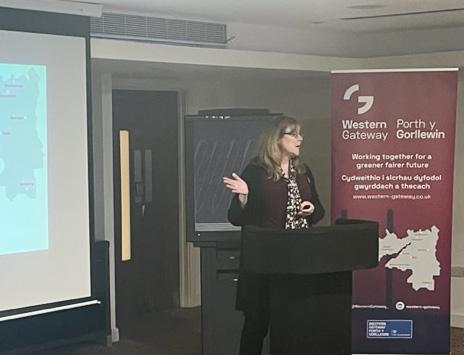
She said: “It is about planning and engaging communities from the beginning. We must keep that conversation going and recognise that these projects are going to be longlasting. This isn’t going to be a five-year investment, some of the major infrastructure projects might be going on for another 120 years, we need to have that longerterm vision.”
She continued to express that it is crucial that the community is at the heart of future plans: “It requires commitment and engagement from everyone involved. I think that we’ve got a lot to crack in terms of bringing communities with us.”
Richard added that through the Combined Authority and the Local Enterprise Partnership, work on how better support can be given to the Black and Minoritised community in the region has been explored: “We’re working with the Black South West Network and another organisation, and that team graduated the back end of last year.”
“It was brilliant because we had industry sitting alongside the university, college, and the community to think about the skills transition. It struck me at the end of it all that the reality for all of us in the room is in the hands of those young people from our wider community. They will drive the success of us and we’re already seeing some brilliant benefits of these activities.”
South West region’s timeline on hydrogen progression
When asked about the timeline on progression, David touched on some of the projects and targets Hydrogen South West has in the next five to ten years.
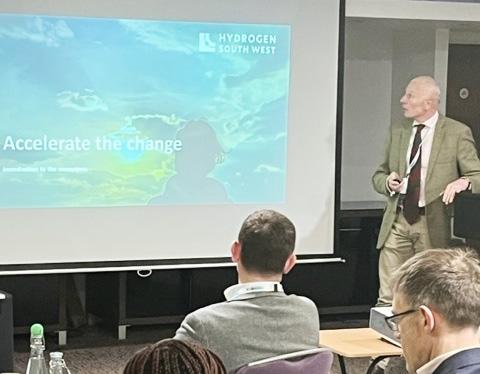
“We have got the Bristol Port project, we want to get that ready for the next wave of net zero hydrogen funding this year and then into planning and construction. Planning could potentially be a constraint, so we want to start planning and construction to be operational by the end of 2025, or beginning of 2026.”
From a Western Gateway point of view, Debby explained that the focus is on strategy: “We are developing our work stream and our activities over the next year and get some funding for that. This is a practical hands-on delivery side to mobilise the strategy to ensure it is not going to sit on the shelf, we want to put people together and make it happen.”
The key takeaways from the panel discussion were that if the UK is to unlock the full potential that hydrogen can bring to the economy, then maximising the cluster of projects across the country is necessary and that the South West region is uniquely placed to offer many opportunities for hydrogen production, storage, and distribution.

CLIMATE ANXIETY
CLIMATE ANXIETY: IS EDUCATION THE BEST MEDICINE?
As a recent YouGov poll revealed that one in three Gen Z in Britain are scared, sad and pessimistic about climate change, what role can education play in encouraging young people into the renewable sector to solve the climate crisis?
The total sample size of the poll was 2,133 adults, of which 226 were aged 16-24. Fieldwork was undertaken between 08 and 10 February 2023, with the survey carried out online.
The main findings of the poll highlighted that one in three young people in Britain is scared (33%), sad (34%), or pessimistic (34%) about climate change, with 28% feeling “overwhelmed”, according to a YouGov poll.
Climate change is a core issue for those under 25
As part of a nationally representative sample, the survey by the Woodland Trust found deep concerns about the future among 16-24-year-olds, with almost one in four (24%) saying fears over the climate crisis mean they are willing to consider or have already decided, to have fewer children than they would otherwise like. Research showed that although seven out of 10 young people are worried about climate change and its effects, 86% of people surveyed felt that being outdoors and among nature had a positive effect on their mental health.
Woodland Trust chief executive Dr Darren Moorcroft said that, with access to woodland declining and tree cover in the UK one of the lowest in Europe, the results were “alarming”.
He insisted: “Young people are experiencing an epidemic of climate anxiety and are increasingly worried about the health of the planet. This new data shows that climate change is jeopardising more than just the environment, with people’s mental wellbeing and future life plans also affected.”
A further statistic from the poll showed that only 9% of people aged 16-24 felt young people have a great deal of influence in making decisions about climate change. It is integral that young people have a voice in climate decisions, and introducing people into the sector at a young age is an essential part of this.
With the current skills gap in the sector growing wider as more people retire and fewer apprenticeships and qualifications are taken up, the renewable sector, and in turn the hydrogen sector, is at real risk of stagnation, heightening climate anxiety. Access to outdoor spaces has never been more important
With climate anxiety an ever-increasing issue, Hayley Jarvis, head of physical activity for the mental health charity Mind, said outdoor activities could be a great way to improve mental wellbeing.
“Ecotherapy, a type of formal treatment which involves doing activities outside in nature, can be as effective as antidepressants in treating mild to moderate depression and anxiety,” she added.
“Unlike working out in the gym or other indoor activities, the colours, sounds and smells we find outdoors stimulate our senses in a different way and can boost our mood. Getting away from modern life and into a relaxing outside space can allow us to switch off from everyday pressures, help relieve stress, and give us time to clear our heads.”
Education is the best medicine
The Woodland Trust has more than 1,000 woods across the UK. They are all free to visit and are the perfect way to get nature therapy. To find your nearest wood, just enter your postcode in the Woodland Trust’s handy wood finder tool.
The Woodland Trust, the largest woodland conservation charity in the UK, has launched its ‘Plant More Trees’ climate campaign with a mission to plant 50 million more native trees across the UK
by 2030 and create a greener, healthier world for people and wildlife.

Three-quarters of all people surveyed in the YouGov poll would be willing to plant or have already planted a tree, with only 9% saying they would not be willing to do this.
The Trust has already planted more than eight million trees of the 55 million trees they have planted since 1972, with young people and children.
Dr Moorcroft continued: “There is hope, but we need to take drastic action. Woodland cover in the UK is desperately low, and we want to see it increase to at least 19% by 2050.
“Trees and woods are integral to tackling both the nature and climate crises, but many young people miss out on both the physical and mental health benefits of being among nature.”
KEY FINDINGS FROM THE REPORT:
• 16-24s more likely to be ‘very worried’ about climate change vs age 50+, with nearly 1 in 3 (31%) ‘very worried’ compared to 23% of 50-64-year-olds and 18% of those aged 65 and over.
• 65% of people are worried about climate change, with 25% (one in four) very worried. Women (69%) are more worried than men 61%.
• 20% of people aged 16-24 would be willing to have fewer children than they would like to address climate change.
• 30% of 25-49 would be willing to or have already decided to have fewer children than they would like.
INTERNATIONAL PROJECTS
HYDROGEN PROJECTS FROM AROUND THE WORLD
Texas
HydrogenPro has announced it will expand in the US with a new plant in Texas with a manufacturing capacity of 500 MW.

The move will increase HydrogenPro’s manufacturing capacity to 800 MW, representing a major milestone in establishing a global presence.
It is estimated that the total investment will cost up to USD 50 million, and the investment cost includes a separate advanced electrode manufacturing facility, which the company says represents a technology “gamechanger” in its solutions offering.
HydrogenPro’s top priority is the US market, CEO Tarjei Johansen explained that manufacturing capacity in the US provides a fundamental platform to succeed: “The US factory will be our bridgehead into the North American market.
“A key factor for us to become the leading provider of green hydrogen technology and systems is our presence across continents, securing sustainable and local supply chains.”
Oman
Oman has signed $20 billion of green hydrogen deals to help achieve its sustainable energy targets.

Salim Al-Aufi, Chairman of Hydrogen Oman (Hydrom), a subsidiary of Energy Development Oman, has signed multiple term sheets with green hydrogen projects. The six projects are located in the proximity of Duqm or Salalah ports, including BP Alternative Energy Investments Limited, Green Energy Oman, Green Hydrogen and Chemicals SPC, Hyport Duqm consortium and SalalaH2 consortium.
These projects will require an installed capacity of approximately 15GW of renewable energy in the country and are expected to provide more than 700,000 tonnes of green hydrogen.
Oman aims to increase green hydrogen production from 32,500 to 3.75 million tonnes per year by 2040.
The country estimates that it will need a cumulative investment of $140 billion over this period to reach its production target by 2050.
Czech Republic

ORLEN Group has announced the launch of a new hydrogen refuelling station at the ORLEN Benzina facility in Prague.
The station will provide environmentally friendly fuel for cars, trucks, and buses in the Czech Republic.
It features two dispensers that come equipped with specially designed gun noses that offer a pressure of 700 bar for cars and 350 bar for larger vehicles.
ORLEN Unipetrol has set ambitious goals to provide up to 28 hydrogen filling stations across the Czech Republic by 2030, along with two hydrogen distribution terminals for rail transport in Litvinov and Neratovice.
Later this year, ORLEN Group will introduce hydrogen stations in Poznan and Katowice, allowing drivers in Poland to fill up their cars with eco-friendly fuel.
By mid-2025, further ORLEN hydrogen stations in Bielsko-Biala, Gorzow Wielkopolski, Walbrzych, Krakow, Pila, and Warsaw will be operational.
It is said that the expansion of traditional and alternative fuels to include hydrogen is a significant step towards low and zeroemission individual and public transport.
Brazil
Unigel has signed a MoU with thyssenkrupp nucera to increase the capacity of its green hydrogen plant in Brazil. Hydrogen Industry Leaders looks at how this will help to boost Brazil’s hydrogen economy.

According to thyssenkrupp nucera, Unigel’s plant in Bahia will be the first industrial-scale green hydrogen plant in Brazil and is planned to be delivered at the end of the year.
In the first phase, the plant is expected to have a total water electrolysis capacity of 60 MW with thyssenkrupp nucera standard electrolysers and an initial production capacity of 10,000 tonnes/year of green hydrogen and 60,000 tonnes/year of green ammonia.
It has been revealed by thyssenkrupp nucera that green hydrogen and green ammonia will be offered to customers seeking to decarbonise their production chains such as the steel industry, oil refineries, and ammonia producers. In addition, green ammonia will be used in Unigel’s value chain.
Werner Ponikwar, CEO and Chairman of thyssenkrupp nucera, explained that this hydrogen plant will be crucial to boosting Brazil’s hydrogen economy.
Building the Hydrogen Economy
LONDON 20 2 3
The Radisson Hotel and Conference Centre, Heathrow
5 July 2023
Making the best use of existing infrastructure, ensuring final investment decisions are improved and building a future-proof hydrogen economy are integral aspects of building a secure hydrogen economy. HIL London will explore how the UK is performing in all these areas and the opportunities in the region.

• How do we build a future-proof hydrogen economy?
• What type of infrastructure will the industry need to develop/retrofit?
• How do we boost the amounts of final investment decisions?
• What are the main bottlenecks, and how do we make the most of these opportunities?
hydrogenindustryleaders.com #
